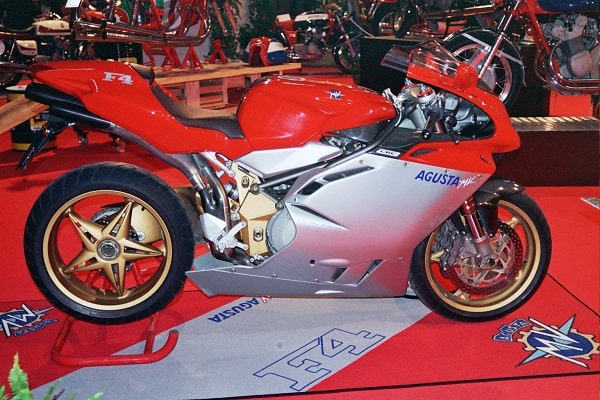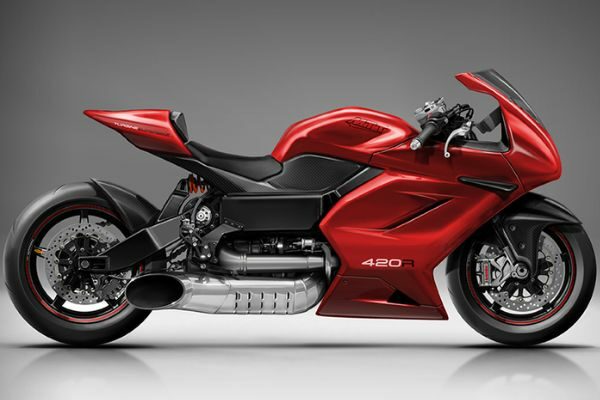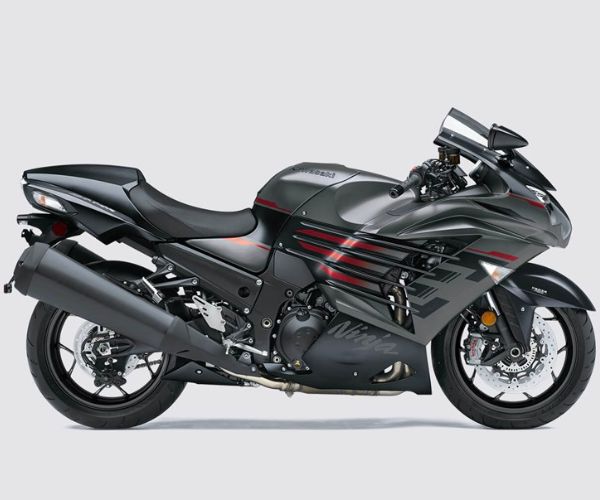There are lots of things to consider when buying a new bike. Laws, restrictions, fuel economy, power, durability…
But not today.
Today we’re looking at the fastest motorcycles currently made on earth.
To make it onto our list, a bike only needs to be outrageously fast. We’ve made no concession to practicality, budget, service costs, or any factor other than all-out speed.
Serious G-force ahead.
Save Money On Your Motorcycle Insurance
- You could pay less than £195*
- Compare quotes from 25+ UK providers
- Fill in one form to compare top bike insurers
Fast Motorcycles Comparison Table
| Motorcycle Name | Weight | Power | Top Speed |
|---|---|---|---|
| MTT 420-RR | 226kg | 420hp | 273mph |
| Kawasaki Ninja H2 | 216kg | 207hp | 209mph |
| Ducati Panigale V4 R | 193kg | 218hp | 198mph |
| Suzuki GSX1300 R Hayabusa | 264kg | 156hp | 194mph |
| BMW S1000RR | 197kg | 205hp | 188mph |
| Kawasaki Ninja ZX 14R | 269kg | 200hp | 186mph |
| MV Agusta F4 1000 | 183kg | 195hp | 180mph |
MTT 420-RR
- Top Speed: 273 mph
- Engine: 250-C20 Series Gas Turbine
- Power: 420hp
- Weight: 226kg
The MTT 420 is a bike many people have heard of, but few have witnessed in real life. The music group Idles has also immortalized this one in song after their singer had a near-death experience involving a MT 420.
Apart from pop culture relevance, these machines have several unique selling points. Perhaps chief among these is that this is a turbine engine squeezed into a motorcycle frame, producing an eye-watering 420bhp.
This explains the longer-than-usual swingarm on the 420 – the engineers needed to make space for the turbine!
This Rolls Royce Allison engine produces 500ft/lbs of torque. Even if these numbers don’t mean much to you, compare the raw figures with those of a “normal” commuter motorcycle. The Suzuki GSX R 600 – a bike beloved for its power and performance creates only 49.9ft/lbs of torque, as a comparison.
This is, however, mostly a concept bike. And more than all the others on our list, this machine is hard to ride at road legal speeds.
The acceleration and torque can probably be experienced throughout its power band. But a track day will be required to experience that monster top end.
Popular US talk show host and bike enthusiast Jay Leno described the feeling of riding an MTT 420 as “like the hand of God pushing you in the back.”
Check it out on Marine Turbine
Kawasaki Ninja H2
- Top Speed: 209mph
- Engine: 4-stroke
- Power: 207hp
- Weight: 216kg
This road-legal version of Kawasaki’s race-only Ninja H2R packs a serious punch.
Smooth, wildly fast acceleration is something most of the Ninja series do well. And the H2 is no exception in that department. It eats up the road, even when not at the higher end of the revs.
Compared to some of the other monster bikes on our list, the Ninja H2 is quite forgiving. Many bikes in this class demand you ride them close to the redline to feel the power. Not so here.
Some of this is down to the extensive suite of rider aids like traction control, engine braking control, and launch control. But upgraded brakes in the post-2015 models also inspire confidence. These later models use heavy-duty Stylema Brembos brakes, better suited to getting the H2’s power under control.
Self-healing paint is a unique feature of the newest models. From what we can gather, this is like a partially cured layer of paint/gel coat. When that top layer receives minor scuffs or scratches, the gel seeps over the damage slowly to fill in the mark.
It’s an interesting idea, but it won’t fix larger paint chips from stones or deep gouges from a crash. It’ll also be interesting to see how that paint is holding up in ten years.
Ducati Panigale V4 R
- Top Speed: 198mph (unmodified ECU)
- Engine: 4-Stroke V4
- Power: 218hp
- Weight: 193kg
Legally, there’s no way to ride a MotoGP bike on the road. But the Ducati Panigale V4 R is about as close as you can get without falling foul of the law. Or at least that’s what Ducati fans and the company’s copy would tell us.
And the numbers do add up, with the Panigale producing 218hp (while still passing Euro-5 regulations). According to converts, it feels nothing like a road bike.
Of course, this also has its drawbacks. Other bikes on our list have a host of electronic rider aids, intertial measurement devices, and concessions to road riding, which give users a sense of confidence.
These features are mostly absent from the Panigale.
It’s a bike that doesn’t mind letting you know if you’re doing it wrong. Only advanced riders with a decent level of strength can get the most from one of these. The rest of us can barely hang on.
Aesthetically, there’s not much between this bike and its track counterpart. The low-slung front end, high-routed exhaust, and razor-thin seat all contribute to an aggressive look.
It’s also tastefully simple for a superbike.
The budget here has been spent on making the Panigale as powerful and lightweight as possible. There are very few carbon fibre doodahs and burnt titanium mickey whistles here. It’s beautiful, scary, and very Italian.
Suzuki GSX1300 R Hayabusa
- Top Speed: 194mph
- Engine: 1340cc 4-stroke in-line
- Power: 156hp
- Weight: 264kg
There aren’t many bikes with the reputation of the Hayabusa. This model has been the leader of the class it created for almost two decades, establishing new performance levels on the track and road.
Its introduction in 1999 made it the fastest bike available, with a top speed of 194mph. But that isn’t the whole story of the Hayabusas. People love them because Suzuki has managed to corral that power and speed into a package that’s also fun to ride.
The latest edition manages to pass the Euro-5 emissions laws while keeping most of the grunt.
Electronic rider aids are also a big part of this new model. Suzuki’s Intelligent Ride System and Inertial Measurement Unit constantly record and collate data. This helps to optimize performance overall, making handling predictable, light, and nimble.
Ten traction control modes are included (it can be switched off entirely). The higher the number selected, the quicker the system will engage and limit wheel spin.
Engine brake control also helps to avoid rear wheel skidding or unpredictable behaviour when decelerating.
All in all, there are other bikes with comparable power to the Hayabusa. But it does carve out a unique place for itself as the least intimidating superbike on our list.
BMW S1000RR
- Top Speed: 188mph
- Engine: 4-Cylinder
- Power: 205hp
- Weight: 197kg (wet)
Lightweight, aerodynamic, and wildly powerful, the S1000RR has taken home multiple Isle of Mann TT championships. Everything present in this model is geared toward speed and performance. However, the inclusion of numerous rider modes means this isn’t totally unruly on the streets.
Rain, road, dynamic, and race modes allow fine-tuning according to conditions. Traction control and ABS also do an excellent job of keeping your ride stable and secure. The fully adjustable front and rear suspension help with this.
The Dynamic Damping Control system (DDC) is ideal for the rigours of the track and twisty country roads.
The S1000RR is a surprisingly comfortable bike too. Comfort is not usually a significant factor in the design of racing machines. But BMW has managed to engineer a seat and seating position that is quite roomy and comfortable for a race bike.
The standard version of this bike is already a powerful, top-shelf experience. But those looking to take things even further can invest in a host of optional extras. These include lightweight wheels, heated grips, cruise control, etc.
MV Agusta F4 1000

- Top Speed: 180mph
- Engine: 4-cylinder inline
- Power: 195hp
- Weight: 183kg
MV Agusta’s used to be at the higher end of the superbike cost scale. And while they’re by no means cheap nowadays, you can pick one up for less than a Panigale or BMW S1000RR.
Serious overhauls to the F4 started in 2013. Updates included a ride-by-wire throttle, a short-stroke engine, and a range of electronic rider aids.
These changes have brought the F4 on par with its Japanese counterparts regarding rideability. No matter your speed, this bike feels light and nimble.
The feats of strength required to hold onto and turn some superbikes are not present here.
Four riding modes are included to help keep things under control in a variety of situations. Eight-stage traction control also helps you avoid wheel slip and spin.
The one complaint we’ve heard levelled against the F4 is its slightly uneven power delivery. It feels somewhat underpowered at the lower end of the range, powerful in the mids, and then hits a weird flat spot before delivering powerful top-end performance.
Still, Agustas are the kind of bike many people grew up seeing on posters and in magazines. We won’t judge if you buy one. We might even ask for a go.
Kawasaki Ninja ZX 14R
- Top Speed: 186mph
- Engine: 4-Stroke DOHC
- Power: 200hp
- Weight: 269kg
At its launch, the ZX 14R was the fastest accelerating bike you could ride on the road (beating Suzuki’s Hayabusa). Though it may have lost that coveted top spot, the ZX is still (unsurprisingly) a fast bike. And it has an excellent reputation for durability and reliability.
Later models of the ZX have some significant engine differences. All models produce serious power (around the 200hp range), but the newer ones use lighter pistons with bypass holes to minimize pumping loss. This also makes the bike more fuel-efficient in addition to the power boost.
And despite its power, weight, and float-out speed, the ZX Ninja feels surprisingly light and agile. The steering is well-balanced. And, when backed up by the engine’s grunt, it’s easy to flick the bike into the position on the road you want.
Its chunky, elongated body seems like it would be cumbersome at first glance. But clever balance and plenty of power across the range make this quite forgiving overall.






